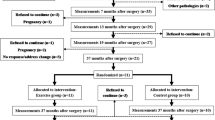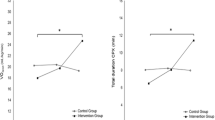Abstract
Background
There is a growing consensus that bariatric surgery is currently the most efficacious and long-term treatment for clinically severe obesity. However, it remains to be determined whether poor physical fitness, an important characteristic of these patients, improves as well. The purpose of this pilot study is to investigate the effect of gastric bypass surgery on physical fitness and to determine if an exercise program in the first 4 months is beneficial.
Methods
Fifteen morbidly obese patients (BMI 43.0 kg/m2) were tested before and 4 months after gastric bypass surgery. Eight of them followed a combined endurance and strength training program. Before and after 4 months the operation, anthropometrical characteristics were measured, and an extensive assessment of physical fitness (strength, aerobic, and functional capacity) was performed.
Results
Large-scale weight loss through gastric bypass surgery results in a decrease in dynamic and static muscle strength and no improvement of aerobic capacity. In contrast, an intensive exercise program could prevent the decrease and even induced an increase in strength of most muscle groups. Together with an improvement in aerobic capacity, functional capacity increased significantly. Both groups evolved equally with regard to body composition (decrease in fat mass and fat-free mass).
Conclusions
An exercise training program in the first 4 months after bariatric surgery is effective and should be promoted, considering the fact that physical fitness does not improve by weight loss only.

Similar content being viewed by others
References
Buchwald H, Williams SE. Bariatric surgery worldwide 2003. Obes Surg. 2004;14:1157–64.
Hedley AA, Ogden CL, Johnson CL, et al. Prevalence of overweight and obesity among us children, adolescents, and adults, 1999–2002. JAMA. 2004;291:2847–50.
Bult MJ, Van DT, Muller AF. Surgical treatment of obesity. Eur J Endocrinol. 2008;158:135–45.
Elder KA, Wolfe BM. Bariatric surgery: a review of procedures and outcomes. Gastroenterology. 2007;132:2253–71.
Farrell TM, Haggerty SP, Overby DW, et al. Clinical application of laparoscopic bariatric surgery: an evidence-based review. Surg Endosc. 2009;23:930–49.
Must A, Spadano J, Coakley EH, et al. The disease burden associated with overweight and obesity. JAMA. 1999;282:1523–9.
Bray GA. Medical consequences of obesity. J Clin Endocrinol Metab. 2004;89:2583–9.
National Task Force on the Prevention and Treatment of Obesity. Overweight, obesity, and health risk. Arch Intern Med. 2000;160:898–904.
Kral JG, Naslund E. Surgical treatment of obesity. Nat Clin Pract Endocrinol Metab. 2007;3:574–83.
Torquati A, Lutfi R, Abumrad N, et al. Is Roux-En-Y gastric bypass surgery the most effective treatment for type 2 diabetes mellitus in morbidly obese patients? J Gastrointest Surg. 2005;9:1112–6.
Clements RH, Gonzalez QH, Long CI, et al. Hormonal changes after Roux-En Y gastric bypass for morbid obesity and the control of type-II diabetes mellitus. Am Surg. 2004;70:1–4.
Pietilainen KH, Kaprio J, Borg P, et al. Physical inactivity and obesity: a vicious circle. Obesity (Silver Spring). 2008;16:409–14.
Telford RD. Low physical activity and obesity: causes of chronic disease or simply predictors? Med Sci Sports Exerc. 2007;39:1233–40.
Stefan MA, Hopman WM, Smythe JF. Effect of activity restriction owing to heart disease on obesity. Arch Pediatr Adolesc Med. 2005;159:477–81.
Carey DG, Pliego GJ, Raymond RL, et al. Body composition and metabolic changes following bariatric surgery: effects on fat mass, lean mass and basal metabolic rate. Obes Surg. 2006;16:469–77.
Poitou BC, Ciangura C, Coupaye M, et al. Nutritional deficiency after gastric bypass: diagnosis, prevention and treatment. Diabetes Metab. 2007;33:13–24.
Brown M, Sinacore DR, Host HH. The relationship of strength to function in the older adult. J Gerontol A Biol Sci Med Sci. 1995;50:55–9.
Wolfson L, Judge J, Whipple R, et al. Strength is a major factor in balance, gait, and the occurrence of falls. J Gerontol A Biol Sci Med Sci. 1995;50:64–7.
Maffiuletti NA, Jubeau M, Munzinger U, et al. Differences in quadriceps muscle strength and fatigue between lean and obese subjects. Eur J Appl Physiol. 2007;101:51–9.
Maffiuletti NA, Jubeau M, Agosti F, et al. Quadriceps muscle function characteristics in severely obese and nonobese adolescents. Eur J Appl Physiol. 2008;103:481–4.
Maniscalco M, Zedda A, Giardiello C, et al. Effect of bariatric surgery on the six-minute walk test in severe uncomplicated obesity. Obes Surg. 2006;16:836–41.
Tompkins J, Bosch PR, Chenowith R, et al. Changes in functional walking distance and health-related quality of life after gastric bypass surgery. Phys Ther. 2008;88:928–35.
Mathier MA, Ramanathan RC. Impact of obesity and bariatric surgery on cardiovascular disease. Med Clin North Am. 2007;91:415–31.
He J, Watkins S, Kelley DE. Skeletal muscle lipid content and oxidative enzyme activity in relation to muscle fiber type in type 2 diabetes and obesity. Diabetes. 2001;50:817–23.
Houmard JA. Intramuscular lipid oxidation and obesity. Am J Physiol Regul Integr Comp Physiol. 2008;294:R1111–6.
Kelley DE. Skeletal muscle fat oxidation: timing and flexibility are everything. J Clin Invest. 2005;115:1699–702.
Toledo FG, Menshikova EV, Azuma K, et al. Mitochondrial capacity in skeletal muscle is not stimulated by weight loss despite increases in insulin action and decreases in intramyocellular lipid content. Diabetes. 2008;57:987–94.
Tanner CJ, Barakat HA, Dohm GL, et al. Muscle fiber type is associated with obesity and weight loss. Am J Physiol Endocrinol Metab. 2002;282:E1191–96.
Rice B, Janssen I, Hudson R, et al. Effects of aerobic or resistance exercise and/or diet on glucose tolerance and plasma insulin levels in obese men. Diabetes Care. 1999;22:684–91.
Janssen I, Fortier A, Hudson R, et al. Effects of an energy-restrictive diet with or without exercise on abdominal fat, intermuscular fat, and metabolic risk factors in obese women. Diabetes Care. 2002;25:431–8.
Kushner RF, Schoeller DA. Estimation of total body water by bioelectrical impedance analysis. Am J Clin Nutr. 1986;44:417–24.
Pace HV, Rathbun EN. Studies on body composition, body water and chemically combined nitrogen content in relation to fat content. J Biol Chem. 2009;158:685–91.
Enright PL. The six-minute walk test. Respir Care. 2003;48:783–5.
Wasserman K, Whipp BJ, Koyl SN, et al. Anaerobic threshold and respiratory gas exchange during exercise. J Appl Physiol. 1973;35:236–43.
Stiegler P, Cunliffe A. The role of diet and exercise for the maintenance of fat-free mass and resting metabolic rate during weight loss. Sports Med. 2006;36:239–62.
Chaston TB, Dixon JB, O'brien PE. Changes in fat-free mass during significant weight loss: a systematic review. Int J Obes (Lond). 2007;31:743–50.
Webster JD, Hesp R, Garrow JS. The composition of excess weight in obese women estimated by body density, total body water and total body potassium. Hum Nutr Clin Nutr. 1984;38:299–306.
Folland JP. AG. The adaptations to strength training: morphological and neurological contributions to increased strength. Sports Med. 2007;37:145–68.
Blimkie CJ, Sale DG, Bar-Or O. Voluntary strength, evoked twitch contractile properties and motor unit activation of knee extensors in obese and non-obese adolescent males. Eur J Appl Physiol Occup Physiol. 1990;61:313–8.
Pescatello LS, Kelsey BK, Price TB, et al. The muscle strength and size response to upper arm, unilateral resistance training among adults who are overweight and obese. J Strength Cond Res. 2007;21:307–13.
Hulens M, Vansant G, Lysens R, et al. Study of differences in peripheral muscle strength of lean versus obese women: an allometric approach. Int J Obes Relat Metab Disord. 2001;25:676–81.
Bohannon RW. Body weight-normalized knee extension strength explains sit-to-stand independence: a validation study. J Strength Cond Res. 2009;23:309–11.
Bohannon RW. Knee extension strength and body weight determine sit-to-stand independence after stroke. J Strength Cond Res. 2007;23:309–11.
Hulens M, Vansant G, Claessens AL, et al. Predictors of 6-minute walk test results in lean, obese and morbidly obese women. Scand J Med Sci Sports. 2003;13:98–105.
Laukkanen R, Oja P, Pasanen M, et al. Validity of a two kilometre walking test for estimating maximal aerobic power in overweight adults. Int J Obes Relat Metab Disord. 1992;16:263–8.
Mattsson E, Larsson UE, Rossner S. Is walking for exercise too exhausting for obese women? Int J Obes Relat Metab Disord. 1997;21:380–6.
Goran M, Fields DA, Hunter GR, et al. Total body fat does not influence maximal aerobic capacity. Int J Obes Relat Metab Disord. 2000;24:841–8.
Seres L, Lopez-Ayerbe J, Coll R, et al. Increased exercise capacity after surgically induced weight loss in morbid obesity. Obesity (Silver Spring). 2006;14:273–9.
Carroll S, Marshall P, Borkoles E, et al. Efficacy of lifestyle intervention on peak exercise cardiac power output and reserve in premenopausal obese females: a randomised pilot study. Int J Cardiol. 2007;119:147–55.
Kanoupakis E, Michaloudis D, Fraidakis O, et al. Left ventricular function and cardiopulmonary performance following surgical treatment of morbid obesity. Obes Surg. 2001;11:552–8.
Gilbert R, Sipple JH, Auchincloss JH Jr. Respiratory control and work of breathing in obese subjects. J Appl Physiol. 1961;16:21–6.
Corpeleijn E, Saris WH, Blaak EE. Metabolic flexibility in the development of insulin resistance and type 2 diabetes: effects of lifestyle. Obes Rev. 2009;10:178–93.
Acknowledgments
This study was financially supported by a grant from the University Ghent (BOF-project, NR. 01J07007) and by Ethicon Endo-Surgery (A Johnson & Johnson Company). Patients were recruited from the University Hospital Ghent, Belgium (Europe) and from AZ Nikolaas, Sint-Niklaas, Belgium (Europe).
Author information
Authors and Affiliations
Corresponding author
Rights and permissions
About this article
Cite this article
Stegen, S., Derave, W., Calders, P. et al. Physical Fitness in Morbidly Obese Patients: Effect of Gastric Bypass Surgery and Exercise Training. OBES SURG 21, 61–70 (2011). https://doi.org/10.1007/s11695-009-0045-y
Received:
Accepted:
Published:
Issue Date:
DOI: https://doi.org/10.1007/s11695-009-0045-y




